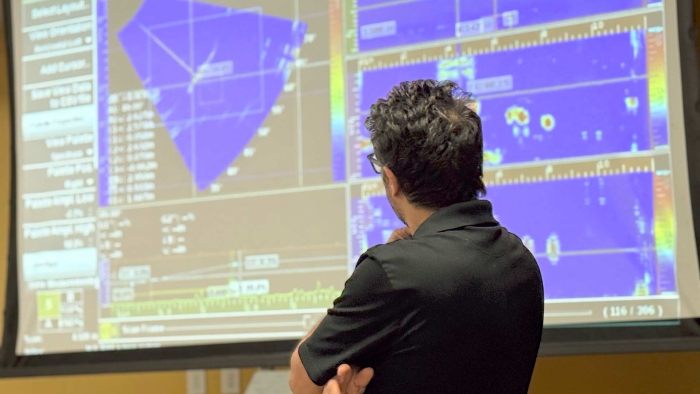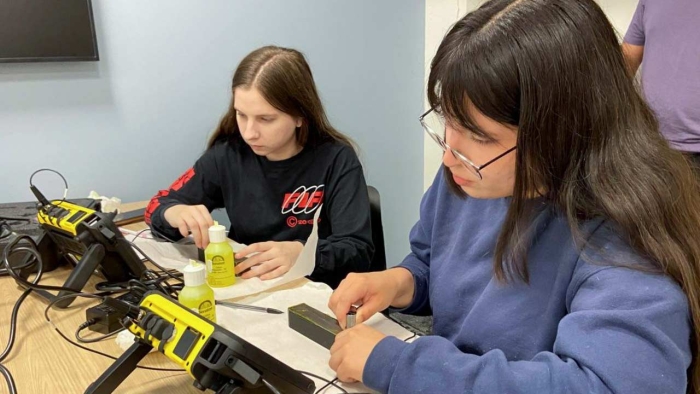How ASU is reshaping manufacturing training

Ehsan Dehghan-Niri, an associate professor of manufacturing engineering in the Ira A. Fulton Schools of Engineering at Arizona State University, demonstrates to students in the Certification to Degree program how to use a nondestructive testing device that employs ultrasound waves to penetrate and detect irregularities. By analyzing the wave reflections displayed on the screen, students can identify potential defects in the material. Photo courtesy of Kurtis Hohman
The manufacturing sector faces a persistent challenge: a shortage of skilled workers.
As industries adopt emerging technologies, traditional training methods struggle to meet the demand for skilled labor. A new initiative led by Arizona State University aims to address this issue through innovative training techniques that incorporate tools such as virtual reality simulation and hands-on training systems.
The challenge
Nondestructive testing, or NDT, plays a vital role in manufacturing by ensuring product safety and reliability, without causing damage. However, training methods in this field have remained stagnant for more than 40 years. Traditional approaches rely on repetitive techniques with limited hands-on learning, creating a gap between what training entails and the realities of advanced manufacturing.
“Our traditional training programs are severely outdated,” says Ehsan Dehghan-Niri, an associate professor of manufacturing engineering in the School of Manufacturing Systems and Networks, part of the Ira A. Fulton Schools of Engineering at ASU, and lead for the Certification to Degree, or C2D, project. “Despite the rapid advancements in technology, training in this field has not reached its fullest potential.”
Compounding this challenge is the rise of advanced manufacturing technologies, such as additive manufacturing and automation, which demand scalable and accessible training programs to meet workforce needs.
An innovative solution
To address this disparity, Dehghan-Niri and his team of expert colleagues secured a $3.5 million grant from the U.S. Department of Defense Manufacturing Engineering Education Program to develop a manufacturing workforce pipeline. The program aims to create a sustainable pool of talented workers prepared to excel in roles essential to supporting the nation’s military forces.
ASU faculty members are collaborating with researchers at New Mexico State University, Navajo Technical University and the American Aerospace Technical Academy to establish the C2D Consortium, which will provide hybrid certification programs focused on STEM-based certifications with potential pathways to degrees and an emphasis on manufacturing.
Dehghan-Niri describes the project’s approach as transformative.
“We’re creating a benchmark for modern training in manufacturing,” he says. “By leveraging the knowledge base of ASU and our collaborating partners, we’re taking workforce training to a whole new level.”
These technologies modernize both the content and delivery of training, making programs more accessible and efficient.
Leveraging technology
A key feature of the C2D project is its interactive cybertool, which replaces expensive, heavy physical samples with virtual equivalents.
During the process, a laptop or tablet functions as both the sample to be tested and as part of an ultrasonic system, through which users interact with a “dummy probe” to simulate real-world testing scenarios. This configuration lowers costs and expands access to training opportunities.
“We’re not eliminating hands-on training,” says Kurtis Hohman, project manager of C2D and a School of Arts, Media and Engineering alum. “Instead, we’re making it much more efficient. Students can now visualize and understand processes like sound wave propagation before applying those skills to real-world scenarios.”
This approach offers learners a deeper understanding of complex concepts while maintaining the hands-on elements that are key to understanding NDT.
Testing the methods
In the last year, C2D has conducted two training classes to assess the impact of these innovations. The project team used comparative studies between traditional and C2D methods to study the impact of the new simulation tools.
The first group used traditional methods, including PowerPoint lectures and limited hands-on practice. The second group trained with the addition of simulation tools, creating a more immersive learning experience.
“While the traditional group answered general questions better, the simulation-trained students excelled in areas directly linked to the new tools,” says Marc Aparicio, a graduate research associate supporting the C2D project.
The simulation-trained group also surpassed the first group on questions related to the new tools, emphasizing the impact of modern training methods in enhancing the understanding and application of complex concepts.
Broader impacts
Beyond refining academic performance, the project explores the effects of highly technical, condensed training programs on participants’ well-being, confidence and career prospects. C2D places a particular emphasis on empowering veterans and individuals from underrepresented groups in the manufacturing industry.
“These programs provide a sense of hope and opportunity,” Dehghan-Niri says. “Participants often feel stuck in their progress, but acquiring these skills opens doors to high-demand jobs, improving their overall career outlook.”
Preliminary surveys indicate that gaining new competencies and certifications significantly boosts participant confidence, giving students a competitive edge in the job market.
Lessons from industry
The project draws inspiration from the health care sector, which has successfully integrated simulation and VR into mandatory training programs. These tools have equipped medical professionals with the expertise needed to handle multifaceted situations, ultimately enabling them to save lives. The C2D team aims to replicate this success in manufacturing, where NDT plays a critical role in preventing catastrophic failures.
“Just as medical training ensures patient safety, modernized NDT training prevents disasters,” Aparicio says. “The failure of a single jet engine could have catastrophic consequences. Proper training saves lives, both in the skies and on the ground.”
By adopting similar methods, the C2D project aims to address workforce shortages and enhance readiness for technical roles, creating a model that fosters both efficiency and inclusivity.
A vision for the future
This initiative addresses immediate workforce needs while laying the groundwork for long-term transformation in technical education. By combining simulation tools with hands-on training, the program prepares participants with practical skills for real-world applications.
As the project evolves, the team aims to expand its model to other technical fields, offering data-driven insights to industry stakeholders and educators. The C2D project will help modernize workforce training to build a skilled, diverse and adaptable workforce ready to meet new challenges.
“We’re not just addressing a workforce shortage,” Dehghan-Niri says. “We’re creating a system that empowers individuals, diversifies the playing field and ensures young minds are prepared for the future of this evolving industry.”
Interested in the future of workforce training?
Visit the C2D project page to learn more about how these innovations are preparing a diverse and skilled workforce for the manufacturing challenges of tomorrow.
More Science and technology

ASU professor shares the science behind making successful New Year's resolutions
Making New Year’s resolutions is easy. Executing them? Not so much.But what if we're going about it all wrong? Does real change take more than just making resolutions?Michelle Shiota thinks so. …

ASU student-run podcast shares personal stories from the lives of scientists
Everyone has a story.Some are inspirational. Others are cautionary. But most are narratives of a person’s path, sometimes a circuitous one, from one point in their lives to another.A new podcast…

The meteorite effect
By Bret HovellEditor's note: This story is featured in the winter 2025 issue of ASU Thrive.On Nov. 9, 1923, Harvey Nininger saw his future explode across the Kansas sky. He would become perhaps the…


